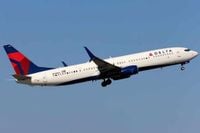Boeing, a name synonymous with commercial aviation, has weathered a turbulent few years. From production slowdowns and regulatory scrutiny to persistent supply chain woes, the company’s annual aircraft output has become a barometer for both its resilience and the health of the broader aerospace industry. Now, as 2025 unfolds, Boeing’s journey to recovery is marked not only by its own cautious ramp-up in jet deliveries but also by new developments in the aftermarket, where passenger planes are finding new life as dedicated freighters.
In 2024, Boeing delivered just 348 commercial aircraft—a stark contrast to its record-setting 806 deliveries in 2018, according to industry data cited by FlightGlobal and AirData News. The past year’s figure was the company’s lowest since the early 2020s, reflecting ongoing challenges from stricter quality inspections, production bottlenecks, and labor disruptions. This decline, while troubling on its face, was also a deliberate move by Boeing’s leadership to prioritize safety and quality over raw output. After all, in the wake of high-profile incidents and investigations, restoring confidence among regulators, customers, and investors became the company’s top priority.
“The pace of certified deliveries remained cautious and measured,” Boeing acknowledged, as reported by AirData News. The factories in Renton and Everett, capable of higher throughput, were forced to slow down as the company enhanced inspection protocols and grappled with shortages of critical components like engines and avionics systems. The result was a growing inventory of jets that, while technically complete, could not yet be handed over to customers due to certification or logistical hurdles.
Yet, there are signs of a rebound. By August 2025, Boeing had delivered 57 aircraft in a single month, including 42 737 MAX jets, 1 737-700, 1 767-2C, 4 777s, and 9 787 Dreamliners, as detailed in AirData News. The company’s cumulative deliveries through the end of August reached 385 aircraft, edging out its European rival Airbus, which had delivered 380. Boeing’s full-year 2025 projection stands at 580 commercial jets—a remarkable 70% increase over 2024’s total, signaling a gradual return to pre-crisis rhythms.
This recovery, however, is fragile. Boeing’s monthly delivery rate currently hovers between 40 and 60 jets, down from the 70-80 per month achieved during its 2018 peak. The company’s ability to ramp up further is constrained by several factors. Regulatory oversight is more stringent than ever, with the FAA exercising direct supervision over Boeing’s quality systems and production rates. Certification delays, especially for the 737 MAX 7 and MAX 10 variants, have limited the company’s ability to boost output. And supply chain disruptions—lingering effects of the pandemic—continue to cause headaches, with even minor shortages capable of stalling entire production lines.
“Boeing stabilized production of the 737 MAX at 38 aircraft per month and received FAA approval to increase to 42 aircraft per month,” AirData News reported. But the company’s future success will depend not only on building new planes but also on clearing the backlog of completed jets awaiting final approval. Each delivery, therefore, represents both a step forward and a clearing of past hurdles.
Looking to the future, industry analysts forecast that Boeing could return to delivering 600–700 aircraft annually by 2026 or 2027, provided it maintains regulatory confidence, supplier performance, workforce stability, and meets global airline demand. But the risks are real: any new quality incident, part shortage, or certification setback could again force Boeing to slow production. The competitive pressure from Airbus, which is projected to deliver 820 aircraft in 2025, adds another layer of urgency to Boeing’s recovery efforts.
While Boeing’s main focus remains on ramping up production and delivery of new jets, the aftermarket is seeing its own surge in innovation. On October 24, 2025, Aeronautical Engineers Inc. (AEI), a Miami-based aircraft modification specialist, announced the launch of a passenger-to-freighter conversion program for the Boeing 737-900ER, as reported by both FlightGlobal and AirData News. This move targets certification by the US Federal Aviation Administration in 2029, with subsequent approvals expected from European and Chinese regulators.
The 737-900ERSF (extended range special freighter) will be the largest and most capable narrowbody freighter in AEI’s lineup. “This is a strategic move to address the increasing demand for higher-capacity narrowbody freighters,” said Robert T. Convey, AEI’s Senior Vice President of Sales and Marketing, as quoted by FlightGlobal. “With the global e-commerce and express markets continuing to grow, the 737-900ERSF will provide operators with the right blend of payload, volume, and economics.”
The conversion will give the 737-900ERSF a cargo space of 206–207 cubic meters (7,273 cubic feet), the ability to accommodate 12 standard cargo pallets, and a maximum payload of 26,172–26,173 kg (57,700 lb). Modifications will include floor reinforcement, a cabin barrier, a cargo loading system supplied by Ancra Aircraft, and a sizeable left-side forward cargo door measuring 2.2 x 3.5 meters. The aircraft will also have an 85.3-tonne maximum take-off weight and seating for five passengers, making it a versatile workhorse for freight operators.
AEI is developing the program under a licensing agreement with Boeing, and while it has not disclosed the number of expected conversions or launch customers, the potential market is significant. Approximately 475 Boeing 737-900ERs remain in active service worldwide, with another 25 in storage—many formerly operated by Indonesia’s Lion Air. Since its introduction in July 2005, Boeing has delivered a total of 505 737-900ER aircraft, according to AirData News.
The timing of AEI’s program reflects a wider trend in aviation. As airlines modernize their fleets and retire older passenger jets, the demand for efficient, high-capacity freighters is on the rise, fueled by the relentless growth of e-commerce and express shipping. The 737-900ERSF, with its blend of volume, payload, and operational economics, is poised to fill a niche for operators needing more capacity than existing narrowbody freighters can provide.
For Boeing, the success of programs like AEI’s 737-900ER conversion is another indicator of the enduring value of its aircraft, even as they transition from passenger service to cargo workhorses. It’s a reminder that the company’s fortunes are tied not just to new production but also to the adaptability and longevity of its designs.
As 2025 draws to a close, Boeing’s path forward is clear but challenging. The company must continue to balance the demands of quality, regulatory compliance, and production efficiency, all while keeping a wary eye on its supply chain and the competitive pressures from Airbus. At the same time, the growing market for freighter conversions offers a new avenue for value and innovation. If Boeing can maintain its current trajectory, steadily increasing output and supporting programs like the 737-900ERSF, it may yet reclaim its position atop the global aerospace industry.





